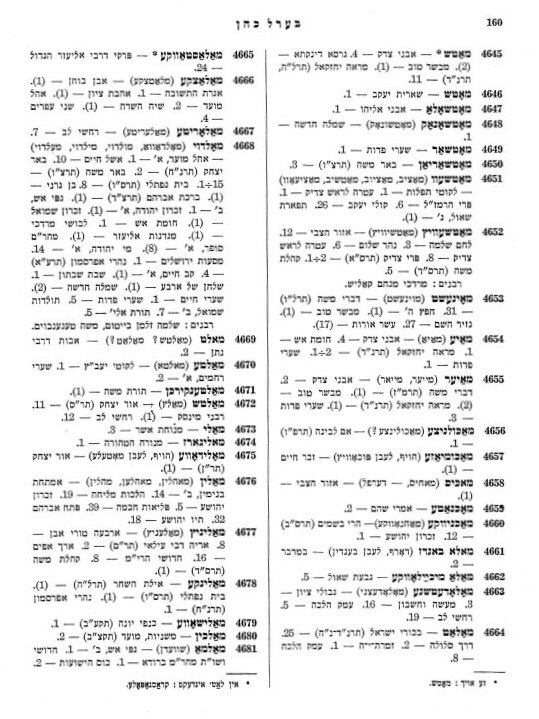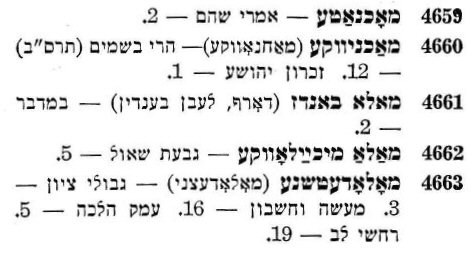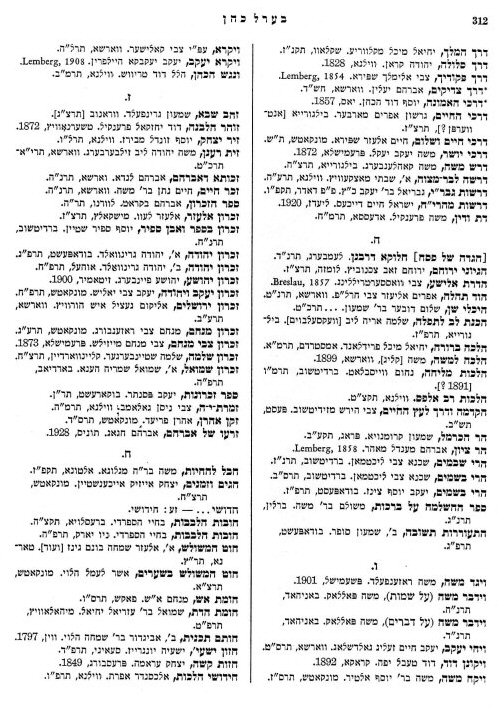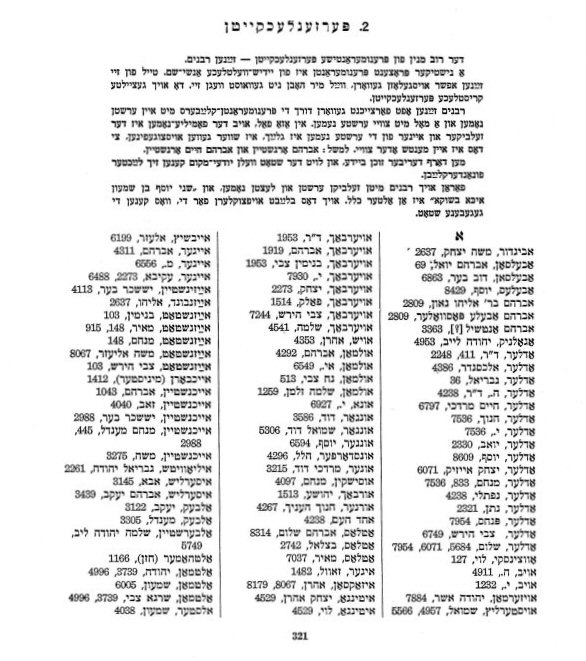|
A Beginner's Guide to Kagan's
Sefer HaPrenumerantn
By: Tom Chatt
Los Angeles, CA, USA
Originally published: September 2004, Updated: March 2016
Background
In the 19th and early 20th century, the business of getting books
published typically required the author to provide front money to the
printer and/or publisher. (It's important to remember that until
recent times, there were very few publishers. Most of the books
listed in Kagan's book were self-published by the author, which is why
funding was needed). This necessitated that the author (or his agents)
would travel to towns and villages, soliciting people who were willing
to make advance payments for the proposed book.
These people were called “pre-subscribers”, or
“prenumerantn”
פּרענומעראַנטן
in Yiddish, and they were typically acknowledged in the
printed edition of the book.
The prenumerantn lists — lists of the
“pre-subscribers” — were typically organized by
town/village name, and then listed each of the individuals, sometimes
with their titles or occupations or relationship to the author.
These lists thus can be a very useful resource in documenting at least
some of the people residing in a given town at a particular time
(and what they were reading!).
The seminal work in cataloging these prenumerantn lists is
Sefer HaPrenumerantn [Hebrew Subscription Lists]
by Berl Kagan.
The work's full Yiddish title is Sefer HaPrenumerantn: Veg vayzer
tsu prenumerirte Hebreishe sforim un zeyre hotmim fun 8,767 kehiles
in Eyrope un Tsofn-Afrike. (New York: Library of the
Jewish Theological Seminary and Ktav Publishing, 1975).
xx, 384, xii pages.
Kagan sifted through numerous 19th century Jewish religious books,
and essentially created an index by town name to the books
in which the towns are listed.
Sefer HaPrenumerantn is one of the sources used in compiling
reference books on Jewish geography, such as Where Once We Walked
by Gary Mokotoff and Sallyann Sack (New Jersey: Avotaynu, 2002),
and Shtetl Finder by Chester Cohen (Los Angeles: Periday, 1980).
In researching a shtetl, you may encounter a reference to the town's
"Kagan number". This is a reference to the numbering of
nearly 9,000 towns made by Kagan in Sefer HaPrenumerantn.
Skills Required
It must be noted that although there is an English introduction, and
brief bits of text in Roman letters, the book is primarily written in
Yiddish and Hebrew, using the Hebrew alphabet. However, because the
book is highly structured (such as a phone book or a dictionary), you may be
able to find the information you need without being fluent in Yiddish.
As long as you have a very basic ability to "decode" Hebrew letters (and
patience in inverse proportion to your skill), you can make use of this
book, following the step-by-step instructions below. (If you are not
completely familiar with Hebrew letters, it will be useful to bring along a
"crib sheet", both to help with "decoding", and to show you Hebrew
alphabetical order.)
Locating the Book
*** Note that this section is no longer relevant,
as Sefer HaPrenumerantn can now be accessed at
HebrewBooks.org. ***
Kagan's Sefer HaPrenumerantn is a rare book, and you may have to
devote some time to finding a copy. Before you go through that effort,
check Where Once We Walked [WOWW], to see if your ancestral
town appears in Sefer HaPrenumerantn.
Look up your town in WOWW, and if one of the sources cited for
your ancestral town is "HSL", that indicates that the town appears in
Sefer HaPrenumerantn.
Some known copies of Kagan's Sefer HaPrenumerantn include:
For other library locations, check
WorldCat under
OCLC #301075514.
Using the Book
Step 1: Find Your Town Number
Each town has a number associated with it in Kagan's system.
Start with "Appendix 5", located around page 340.
(Note that being a Yiddish book, the pages turn in the opposite
direction to what non-Hebrew readers are used to.)
Appendix 5 is an index of geographical names, mapping onto their
"Kagan numbers".
This appendix is printed in the Roman alphabet ("English" text),
with the town names in alphabetical order, so you should be able to
find your town name without trouble. (Just remember that even
in this "English" part of the book, the pages still turn "backwards",
as you pursue the alphabetical order.
If you're not used to it, you will probably trip over it several
times as I did!)
Also, keep in mind that the spelling of town names was never precise,
neither in the original language, nor in the "English" transliteration.
You should be prepared to recognize variations in the spelling of your
town name.
If you have previously looked at Shtetl Finder by Chester Cohen,
which references the Kagan number, you already know your Kagan number.
However, it still may be helpful to verify it. (In my case, I had
copied the number down incorrectly from Cohen.)
Step 2: Find Your Town's Subscriptions

Now turn to the main body of the book, where you will find a listing
of towns in numeric order, from 1 to nearly 9,000. (The numeric
order actually coincides with alphabetical order, but unless you're really
sharp with Hebrew alphabetical order, the number will get you to the
same place faster.)
These entries are all in Yiddish, except for the numbers, which are
"English-style". Next to the number, you will see the name of
your town written in Yiddish, in bold print.
If your town had alternative spellings or alternative names, these
will be listed in parenthesis immediately following the primary name.
Then there will be a dash, followed by a list of "subscription entries".
Going right-to-left, each subscription entry will have the title of
a book, a long dash, a number (represents the number of people in this
town who subscribed to this book), and a period.
Each entry in this list is terminated by a period.
Within a town's list, there are no line-breaks.
Each entry follows the previous one with only a space separation.
Note that some popular books may have had several editions or printings,
and that the subscriber lists are specific to the edition. (That is, if a
book had a "second edition", they would have had to raise new money and
have a new set of subscribers.
Those who pre-subscribed to the first edition would only be acknowledged
in the first edition, etc.)
At the "end" of a book title, you may see a "word" in parenthesis which
has three letters, followed by a double-apostrophe, followed by a fourth
letter, e.g.: TRM"B (that is: tav - resh - mem - " - bet).
These are Hebrew notations for the year of publication.
In Hebrew, the "letters" can do double-duty as numbers.
(For a tool that converts Hebrew letters into a number, see
https://www.jewishgen.org/InfoFiles/m_jyear.htm).
Here is an example of what the structure of the entries looks like:

The above entry for town 4660 is transliterated as follows
(rearranged left-to-right):
4660 MAKHNIVKA (Makhnovka) -- Harei Besamim (TRS"B)
-- 12. Zichron Yehoshua -- 1.
This entry lists two books for the town of Makhnivka.
The first book is entitled "Harei Besamim" published in
Hebrew year TRS"B, which had 12 subscribers from this village.
The second book is entitled "Zichron Yehoshua", which had one
subscriber.
Make a photocopy of this entry (and/or carefully transcribe it).
Click here to see
an example of what a full page of town listings looks like.
You can see that it is highly structured, like a phone book or
dictionary.
See how quickly you can find the entry for town 4660.
Step 3: Get the Full Bibliographic Information
Now turn to the first appendix, which starts around page 310.
In this section, you will find a list of all the books mentioned,
providing more detailed bibliographic information for each.
This section is all in Yiddish/Hebrew, in alphabetical order by
title of book.
By matching up the Hebrew letters (and using a crib-sheet to show
Hebrew alphabetical order, if needed), you should be able to locate
each of the books mentioned for your town.
A typical bibliographical entry has: the title of the book (in bold),
which matches up to the listing from your town, a comma, the name of the
author of the book, a period, the place of publication, a comma, the year
of publication, and a final period.
The year of publication is typically a Hebrew year using Hebrew letters,
but is sometimes an "English" numeral CE year.
Following the example above, I would look for the title
"Harei Besamim" in the section for the Hebrew letter "hey",
and would find the following entries:

Here is how these entries would be transcribed:
HAREI BESAMIM, Shachna Tsvi Lichtman. Berditshov, TRN"Z (1895).
HAREI BESAMIM, Shachna Tsvi Lichtman. Berditshov, TRS"B (1902).
HAREI BESAMIM, Yaakov Yosef Tsinz. Budapest, TRF"Z (1925).

Note that in my case, the town entry had included a title and an edition
year. Because we find that there were three books with the same name
(two editions of the same book, and one different book with the same title),
the year is important to correctly identify the proper entry.
For the town of Makhnivka, the second edition of Harei Besamim
by Lichtman is the right one, because we had to match TRS"B (the year 1902).
Click the image at the right to see an example of
what a full page of bibliography listings looks like.
Notice that it is in Hebrew alphabetical order, with a section
for each letter of the Hebrew alphabet.
Try finding the listings for Harei Besamim
(the example used above).
Step 4: Check the Other Appendices
Kagan also includes a few appendices which may contain information
about your town.
- Appendix 2 (starting on page 321) is an index of book
authors to the towns they came from.
- Appendix 3 (starting on page 334) is an index of
congregations who subscribed to books collectively.
Sometimes a whole congregation, such as the "Kalter Schul" or the
"Bratslaver Shtiebel", would pre-subscribe to a book (especially
prayer books), rather than an individual.
- Appendix 4 (on page 337) is a similar index of "chavarot"
(fraternal lodges) that collectively pre-subscribed.

Each of these appendices maps Hebrew names (of authors, congregations,
and lodges, respectively) onto town numbers. The good news is that
you can easily scan these pages for your town number. The bad news
is that these appendices are not ordered by number, they are ordered
alphabetically by name (of author, congregation, or lodge), so you just
have to scan through the whole thing looking for your town number.
However, it isn't all that long (only about a dozen pages of authors,
three pages of congregations, and one page of lodges), and it will be
worth it if your town is mentioned here. Your town may or may not
be mentioned in these appendices, but you won't know unless you look.
Click the image at the right to see an example of
what a full page of these appendix listings looks like.
Notice that it is in alphabetical order, cross-referenced to the
town number.
This one is the list of author's names, sorted by surname.
You can see what it would be like to scan this page looking for
your particular town number.
A bit tedious, but not too bad for just a handful of pages.
Finding the Actual Prenumerantn Lists
Kagan provides some very useful information about towns you may be
researching, but alas he does not get you all the way to the actual
personal names of the subscribers. For that, you need to take
Kagan's information and find the actual books referenced to see the
subscription lists in them. Keep in mind that you must find the
specific original editions of these books, or else you will not find
the subscription list.
Kagan worked primarily from original sources at the library of the
Jewish Theological Seminary in New York,
so many of these works can be found there. Other good resources
include Brandeis University,
Harvard University, the
Library of Congress, or
UCLA.
All of these have online library catalogs, which can be searched.
Keep in mind that there are no standard rules about how to transliterate
Hebrew titles and Yiddish authors into "English" spellings, so you may
have to try different variations.
Just from an online search, you may be able to learn more about what
these books and authors were that the people in your shtetl were
reading.
I hope you will be able to make use of this valuable resource in
learning more about your shtetl.
Last modified: 30 Mar 2016 WSB
|



